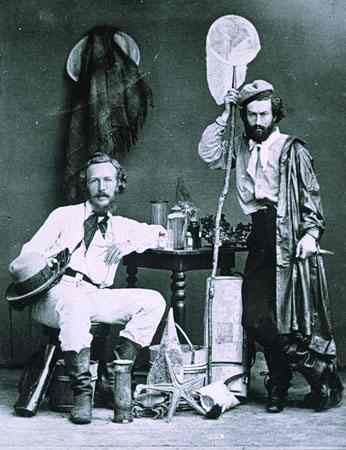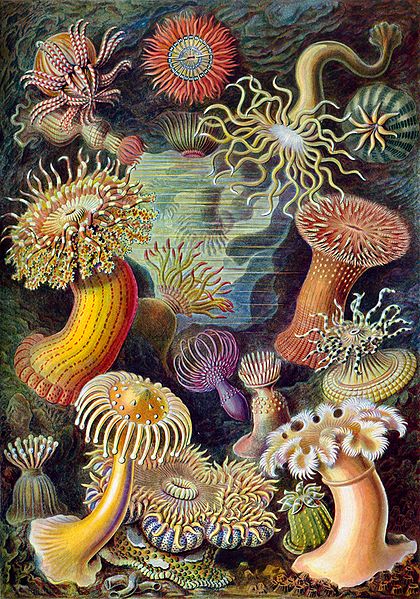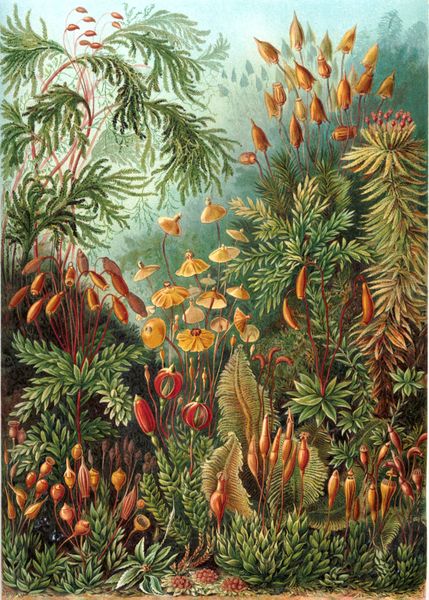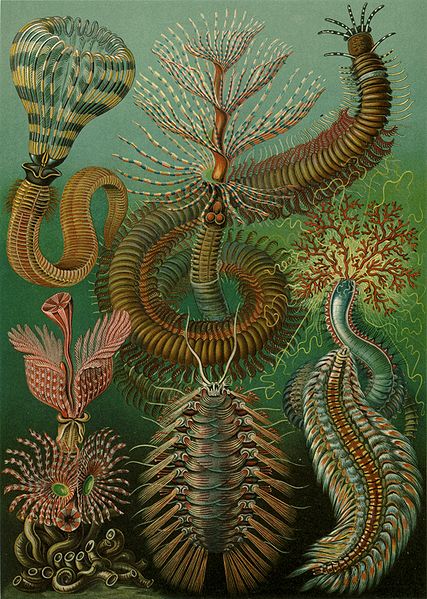<Back to Index>
- Biologist Ernst Heinrich Philipp August Haeckel, 1834
- Painter Andreas Schelfhout, 1787
- Religious Reformer Philipp Melanchthon (Schwartzerdt), 1497
PAGE SPONSOR

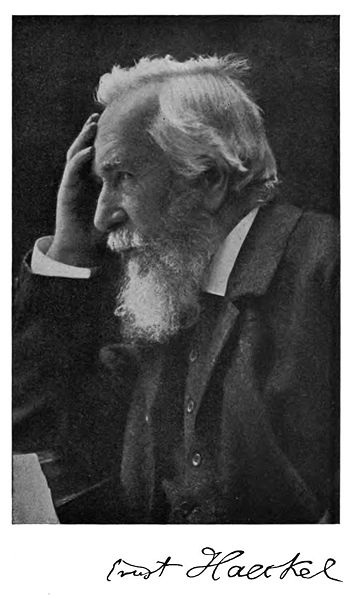
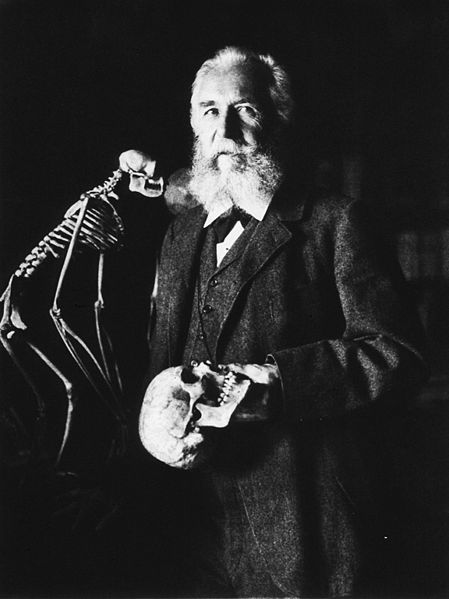
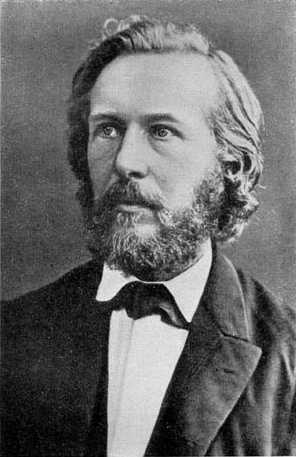
Ernst Heinrich Philipp August Haeckel (February 16, 1834 – August 9, 1919), also written von Haeckel, was an eminent German biologist, naturalist, philosopher, physician, professor and artist who discovered, described and named thousands of new species, mapped a genealogical tree relating all life forms, and coined many terms in biology, including anthropogeny, ecology, phylum, phylogeny, and the kingdom Protista. Haeckel promoted and popularized Charles Darwin's work in Germany and developed the controversial recapitulation theory ("ontogeny recapitulates phylogeny") claiming that an individual organism's biological development, or ontogeny, parallels and summarizes its species' entire evolutionary development, or phylogeny.
The published artwork of Haeckel includes over 100 detailed, multi-colour illustrations of animals and sea creatures (Kunstformen der Natur, "Artforms of Nature"). As a philosopher, Ernst Haeckel wrote Die Welträtsel (1895 – 1899, in English, The Riddle of the Universe, 1901), the genesis for the term "world riddle" (Welträtsel); and Freedom in Science and Teaching to support teaching evolution. In the United States, Mount Haeckel, a 13,418 ft (4,090 m) summit in the Eastern Sierra Nevada, overlooking the Evolution Basin, is named in his honor, as is another Mount Haeckel, a 2,941 m (9,649 ft) summit in New Zealand; and the asteroid 12323 Haeckel. The Ernst Haeckel house ("Villa Medusa") in Jena, Germany, contains a historic library.
Ernst Haeckel was born on February 16, 1834, in Potsdam (then part of Prussia). In 1852, Haeckel completed studies at Cathedral High School (Domgymnasium) of Merseburg. He then studied medicine in Berlin and biology at Würzburg, particularly with Albert von Kölliker, Franz Leydig, Rudolf Virchow (with whom he later worked briefly as assistant), and with anatomist - physiologist Johannes Peter Müller (1801 – 1858). Together with Hermann Steudner he attended botany lectures in Würzburg. In 1857, Haeckel achieved a doctorate in biology (D.Sc.), and then he received a PhD in Zoology at faculty of Biology. He decided not to practice medicine, but to use his degree in Biology. Haeckel studied under Karl Gegenbaur at the University of Jena for three years, earning a doctorate in zoology, before becoming a professor of comparative anatomy at the University of Jena, where he remained for 47 years, from 1862 to 1909. Between 1859 and 1866, Haeckel worked on many invertebrate groups, including radiolarians, poriferans (sponges) and annelids (segmented worms). During a trip to the Mediterranean, Haeckel named nearly 150 new species of radiolarians. Haeckel named thousands of new species from 1859 to 1887.
From 1866 to 1867, Haeckel made an extended journey to the Canary Islands with Hermann Fol and during this period, met with Charles Darwin, in 1866 at Down House in Kent, Thomas Huxley and Charles Lyell. In 1867, he married Agnes Huschke. Their son Walter was born in 1868, their daughters Elizabeth in 1871 and Emma in 1873. In 1869, he traveled as a researcher to Norway, in 1871 to Dalmatia, and in 1873 to Egypt, Turkey, and to Greece. Haeckel retired from teaching in 1909, and in 1910 he withdrew from the Evangelical church. Haeckel's wife, Agnes, died in 1915, and Haeckel became substantially more frail, with a broken leg (thigh) and broken arm. He sold the mansion Medusa ("Villa Medusa") in 1918 to the Carl Zeiss foundation. Haeckel died on August 9, 1919.
Haeckel's political beliefs were influenced by his affinity for the German Romantic movement coupled with his acceptance of a form of Lamarckism. Rather than being a strict Darwinian, Haeckel believed that racial characteristics were acquired through interactions with the environment and that ontogeny directly followed phylogeny. He believed the social sciences to
be instances of "applied biology". Most of these arguments have been
shown to be over-generalizations at best and flatly incorrect at worst
in modern biology and social studies. In
1905, Haeckel founded a group called the "Monist League" to promote his
religious and political beliefs. This group lasted until 1933 and
included such notable members as Wilhelm Ostwald, Georg von Arco, Helene Stöcker and Walter Arthur Berendsohn.
Haeckel was the first person known to use the term "First World War". Shortly after the start of the war Haeckel wrote:
| “ | There is no doubt that the course and character of the feared "European War"... will become the first world war in the full sense of the word. | ” |
- Indianapolis Star, September 20, 1914
The
"European War" became known as "The Great War", and it was not until
1931, with the beginning realization that another global war might be
possible, that there is any other recorded use of the term "First World
War".
Haeckel was a zoologist, an accomplished artist and illustrator, and later a professor of comparative anatomy. Although Haeckel's ideas are important to the history of evolutionary theory, and he was a competent invertebrate anatomist most famous for his work on radiolaria, many speculative concepts that he championed are now considered incorrect. For example, Haeckel described and named hypothetical ancestral microorganisms that have never been found.
He was one of the first to consider psychology as a branch of physiology. He also proposed many now ubiquitous terms including "anthropogeny", "phylum", "phylogeny", "ecology" ("oekologie"), and proposed the kingdom Protista in 1866. His chief interests lay in evolution and life development processes in general, including development of nonrandom form, which culminated in the beautifully illustrated Kunstformen der Natur (Art forms of nature). Haeckel did not support natural selection, rather believing in a Lamarckian inheritance of acquired characteristics (Lamarckism).
Haeckel advanced a version of the earlier "recapitulation theory", previously set out by Étienne Serres in the 1820s and supported by followers of Geoffroy including Robert Edmond Grant, which proposed a link between ontogeny (development of form) and phylogeny (evolutionary descent), summed up by Haeckel in the phrase "ontogeny recapitulates phylogeny". His concept of recapitulation has been refuted in the form he gave it (now called "strong recapitulation"), in favour of the ideas first advanced by Karl Ernst von Baer. "Strong" recapitulation hypothesis views ontogeny as repeating forms of the ancestors, while "weak" recapitulation means that what is repeated (and built upon) is the ancestral embryonic development process. He supported the theory with embryo drawings that have since been shown to be oversimplified and in part inaccurate, and the theory is now considered an oversimplification of quite complicated relationships. Haeckel introduced the concept of "heterochrony", which is the change in timing of embryonic development over the course of evolution.
Haeckel
was a flamboyant figure. He sometimes took great (and non-scientific)
leaps from available evidence. For example, at the time that Darwin
first published On the Origin of Species by Means of Natural Selection (1859),
no remains of human ancestors had yet been found. Haeckel postulated
that evidence of human evolution would be found in the Dutch East Indies (now Indonesia), and described these theoretical remains in great detail. He even named the as-of-yet unfound species, Pithecanthropus alalus, and charged his students to go find it. (Richard and Oskar Hertwig were two of Haeckel's many important students.) One student did find the remains: a young Dutchman named Eugene Dubois went to the East Indies and dug up the remains of Java Man, the first human ancestral remains ever found. These remains originally carried Haeckel's Pithecanthropus label, though they were later reclassified as Homo erectus.
The creationist polygenism of Samuel George Morton and Louis Agassiz, which presented human races as separately created species, was rejected by Charles Darwin, who argued for the monogenesis of the human species and the recent African origin of modern humans. In contrast to most of Darwin's supporters, Haeckel put forward a doctrine of evolutionary polygenism based on the ideas of the linguist August Schleicher, in which several different language groups had arisen separately from speechless prehuman Urmenschen, which themselves had evolved from simian ancestors. These separate languages had completed the transition from animals to man, and, under the influence of each main branch of languages, humans had evolved — in a kind of Lamarckian use-inheritance — as separate species, which could be subdivided into races. From this Haeckel drew the implication that languages with the most potential formed human species with the most potential, led by the Semitic and Indo - Germanic groups, with Berber, Jewish, Greco - Roman and Germanic varieties to the fore. As Haeckel stated:
- We must mention here one of the most important results of the comparative study of languages, which for the Stammbaum of the species of men is of the highest significance, namely that human languages probably had a multiple or polyphyletic origin. Human language as such probably developed only after the species of speechless Urmenschen or Affenmenschen had split into several species or kinds. With each of these human species, language developed on its own and independently of the others. At least this is the view of Schleicher, one of the foremost authorities on this subject.… If one views the origin of the branches of language as the special and principal act of becoming human, and the species of humankind as distinguished according to their language stem, then one can say that the different species of men arose independently of one another.
Haeckel's view can be seen as a forerunner of the multi-regional hypothesis, which until the 1990s remained in contention with developments of Darwin's hypothesis of a recent African origin of modern humans. The multiregional view then fell from favour, and Darwin's view has more recently been validated by the decipherment of the human genome. Haeckel also applied the hypothesis of polygenism to the modern diversity of human groups. He became a leading proponent of scientific racism, stating for instance:
- The Caucasian, or Mediterranean man (Homo Mediterraneus), has from time immemorial been placed at the head of all the races of men, as the most highly developed and perfect. It is generally called the Caucasian race, but as, among all the varieties of the species, the Caucasian branch is the least important, we prefer the much more suitable appellation proposed by Friedrich Müller, namely, that of Mediterranese. For the most important varieties of this species, which are moreover the most eminent actors in what is called "Universal History," first rose to a flourishing condition on the shores of the Mediterranean.… This species alone (with the exception of the Mongolian) has had an actual history; it alone has attained to that degree of civilization which seems to raise men above the rest of nature.
- When Haeckel was a student in the 1850s he showed great interest in embryology, attending the rather unpopular lectures twice and in his notes sketched the visual aids: textbooks had few illustrations, and large format plates were used to show students how to see the tiny forms under a reflecting microscope, with the translucent tissues seen against a black background. Developmental series were used to show stages within a species, but inconsistent views and stages made it even more difficult to compare different species. It was agreed by all European evolutionists that all vertebrates looked very similar at an early stage, in what was thought of as a common ideal type, but there was a continuing debate from the 1820s between the Romantic recapitulation theory that human embryos developed through stages of the forms of all the major groups of adult animals, literally manifesting a sequence of organisms on a linear chain of being, and Karl Ernst von Baer's opposing view that the early general forms diverged into four major groups of specialised forms without ever resembling the adult of another species, showing affinity to an archetype but no relation to other types or any transmutation of species. By the time Haeckel was teaching he was able to use a textbook with woodcut illustrations written by his own teacher Albert von Kölliker, which purported to explain human development while also using other mammalian embryos to claim a coherent sequence. Despite the significance to ideas of transformism, this was not really polite enough for the new popular science writing, and was a matter for medical institutions and for experts who could make their own comparisons.
Haeckel's
aim was a reformed morphology with evolution as the organizing
principle of a cosmic synthesis unifying science, religion, and art. He
was giving successful "popular lectures" on his ideas to students and
townspeople in Jena, in an approach pioneered by his teacher Rudolf Virchow. To meet his publisher's need for a popular work he used a student's transcript of his lectures as the basis of his Natürliche Schöpfungsgeschichte of
1868, presenting a comprehensive gospel of evolution. In the Spring of
that year he drew figures for the book, synthesising his views of
specimens in Jena and published pictures to represent types. After
publication he told a colleague that the images “are completely exact,
partly copied from nature, partly assembled from all illustrations of
these early stages that have hitherto become known.” There were various
styles of embryological drawings at
that time, ranging from more schematic representations to
“naturalistic” illustrations of specific specimens. Haeckel believed
privately that his figures were both exact and synthetic, and in public
asserted that they were schematic like most figures used in teaching.
The images were reworked to match in size and orientation, and though
displaying Haeckel's own views of essential features, they support von
Baer's concept that vertebrate embryos begin similarly and then
diverge. Relating different images on a grid conveyed a powerful
evolutionary message. As a book for the general public, it followed the
common practice of not citing sources.
The
book sold very well, and while some anatomical experts hostile to
Haeckel's evolutionary views expressed some private concerns that
certain figures had been drawn rather freely, the figures showed what
they already knew about similarities in embryos. The first published
concerns came from Ludwig Rütimeyer, a professor of zoology and comparative anatomy at the University of Basel who
had placed fossil mammals in an evolutionary lineage early in the 1860s
and had been sent a complimentary copy. At the end of 1868 his review
in the Archiv für Anthropologie wondered
about the claim that the work was "popular and scholarly", doubting
whether the second was true, and expressed horror about such public
discussion of man's place in nature with illustrations such as the
evolutionary trees being shown to non-experts. Though he made no
suggestion that embryo illustrations should be directly based on
specimens, to him the subject demanded the utmost "scrupulosity and
conscientiousness" and an artist must “not arbitrarily model or
generalize his originals for speculative purposes” which he considered
proved by comparison with works by other authors. In particular, "one
and the same, moreover incorrectly interpreted woodcut, is presented to
the reader three times in a row and with three different captions as
[the] embryo of the dog, the chick, [and] the turtle." He accused
Haeckel of "playing fast and loose with the public and with science",
and failing to live up to the obligation to the truth of every serious
researcher. Haeckel responded with angry accusations of bowing to
religious prejudice, but in the second (1870) edition changed the
duplicated embryo images to a single image captioned "embryo of a
mammal or bird". Duplication using galvanoplastic stereotypes (clichés)
was a common technique in textbooks, but not on the same page to
represent different eggs or embryos. In 1891 Haeckel made the excuse
that this "extremely rash foolishness" had occurred in undue haste but
was "bona fide", and since repetition of incidental details was obvious
on close inspection, it is unlikely to have been intentional deception.
The
revised 1870 second edition of 1,500 copies attracted more attention,
being quickly followed by further revised editions with larger print
runs as the book became a prominent part of the optimistic,
nationalist, anticlerical "culture of progress" in Otto von Bismarck's new German Empire. The similarity of early vertebrate embryos became common knowledge, and the illustrations were praised by experts such as Michael Foster of the University of Cambridge. In the introduction to his 1871 The Descent of Man, and Selection in Relation to Sex, Darwin gave particular praise to Haeckel, writing that if Natürliche Schöpfungsgeschichte "had appeared before my essay had been written, I should probably never have
completed it." The first chapter included an illustration: "As some of
my readers may never have seen a drawing of an embryo, I have given one
of man and another of a dog, at about the same early stage of
development, carefully copied from two works of undoubted accuracy"
with a footnote citing the sources and noting that "Häckel has
also given analogous drawings in his Schöpfungsgeschichte."
The fifth edition of Haeckel's book appeared in 1874, with a
controversial frontispiece featuring the heads of apes and humans
replaced by a heroic portrait of Haeckel himself.
Later in 1874, Haeckel's simplified embryology textbook Anthropogenie made the subject into a battleground over Darwinism aligned with Bismarck's Kulturkampf ("culture
struggle") against the Catholic Church. Haeckel took particular care
over the illustrations, changing to the leading zoological publisher
Wilhelm Engelmann of Leipzig and obtaining from them use of
illustrations from their other textbooks as well as preparing his own
drawings including a dramatic double page illustration showing "early",
"somewhat later" and "still later" stages of 8 different vertebrates.
Though Haeckel's views had attracted continuing controversy, there had
been little dispute about the embryos and he had many expert
supporters, but Wilhelm His now revived the earlier criticisms and introduced new attacks on the 1874 illustrations. Others joined in, both expert anatomists and Catholic priests and supporters politically opposed to Haeckel's views.
While
it has been widely claimed that Haeckel was charged with fraud by five
professors and convicted by a university court at Jena, there does not
appear to be an independently verifiable source for this claim. Recent
analyses (Richardson 1998, Richardson and Keuck 2002) have found that
some of the criticisms of Haeckel's embryo drawings were legitimate,
but others were unfounded. There
were multiple versions of the embryo drawings, and Haeckel rejected the
claims of fraud. It was later said that "there is evidence of sleight
of hand" on both sides of the feud between Haeckel and Wilhelm His. The controversy involves several different issues.
Some creationists have claimed that Darwin relied on Haeckel's embryo drawings as proof of evolution to support their anti-evolution arguments while both On the Origin of Species (1859), and The Descent of Man (1871) were published before Haeckel's double page illustration of eight vertebrate embryos in 1874.
He was awarded the Linnean Society of London's prestigious Darwin - Wallace Medal in 1908.
